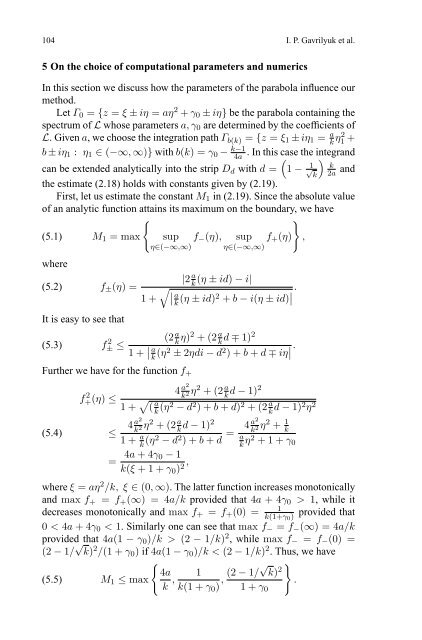H-Matrix approximation for the operator exponential with applications
H-Matrix approximation for the operator exponential with applications
H-Matrix approximation for the operator exponential with applications
You also want an ePaper? Increase the reach of your titles
YUMPU automatically turns print PDFs into web optimized ePapers that Google loves.
104 I. P. Gavrilyuk et al.<br />
5 On <strong>the</strong> choice of computational parameters and numerics<br />
In this section we discuss how <strong>the</strong> parameters of <strong>the</strong> parabola influence our<br />
method.<br />
Let Γ 0 = {z = ξ ± iη = aη 2 + γ 0 ± iη} be <strong>the</strong> parabola containing <strong>the</strong><br />
spectrum of L whose parameters a, γ 0 are determined by <strong>the</strong> coefficients of<br />
L. Given a, we choose <strong>the</strong> integration path Γ b(k) = {z = ξ 1 ± iη 1 = a k η2 1 +<br />
b ± iη 1 : η 1 ∈ (−∞, ∞)} <strong>with</strong> b(k) =γ 0 − k−1<br />
4a<br />
. In this case<br />
(<br />
<strong>the</strong> integrand<br />
)<br />
can be extended analytically into <strong>the</strong> strip D d <strong>with</strong> d = 1 − √ 1 k<br />
k 2a and<br />
<strong>the</strong> estimate (2.18) holds <strong>with</strong> constants given by (2.19).<br />
First, let us estimate <strong>the</strong> constant M 1 in (2.19). Since <strong>the</strong> absolute value<br />
of an analytic function attains its maximum on <strong>the</strong> boundary, we have<br />
{<br />
}<br />
(5.1) M 1 = max<br />
where<br />
(5.2) f ± (η) =<br />
It is easy to see that<br />
sup<br />
η∈(−∞,∞)<br />
f − (η),<br />
sup<br />
η∈(−∞,∞)<br />
f + (η)<br />
|2 a k<br />
(η ± id) − i|<br />
∣∣<br />
a<br />
1+√<br />
k (η ± id)2 + b − i(η ± id) ∣ .<br />
(5.3) f± 2 (2 a k<br />
≤<br />
η)2 +(2 a k d ∓ 1)2<br />
1+ ∣ a<br />
k (η2 ± 2ηdi − d 2 )+b + d ∓ iη ∣ .<br />
Fur<strong>the</strong>r we have <strong>for</strong> <strong>the</strong> function f +<br />
f+(η) 2 ≤<br />
4 a2 η 2 +(2 a k 2 k d − 1)2<br />
1+ √ ( a k (η2 − d 2 )+b + d) 2 +(2 a k d − 1)2 η 2<br />
(5.4) ≤<br />
4 a2 η 2 +(2 a k 2 k d − 1)2<br />
1+ a k (η2 − d 2 )+b + d = 4 a2 η 2 + 1 k 2 k<br />
a<br />
k η2 +1+γ 0<br />
= 4a +4γ 0 − 1<br />
k(ξ +1+γ 0 ) 2 ,<br />
where ξ = aη 2 /k, ξ ∈ (0, ∞). The latter function increases monotonically<br />
and max f + = f + (∞) = 4a/k provided that 4a +4γ 0 > 1, while it<br />
decreases monotonically and max f + = f + (0) =<br />
1<br />
k(1+γ 0 )<br />
provided that<br />
0 < 4a +4γ 0 < 1. Similarly one can see that max f − = f − (∞) =4a/k<br />
provided that 4a(1 − γ 0 )/k > (2 − 1/k) 2 , while max f − = f − (0) =<br />
(2 − 1/ √ k) 2 /(1 + γ 0 ) if 4a(1 − γ 0 )/k < (2 − 1/k) 2 . Thus, we have<br />
{<br />
}<br />
4a<br />
(5.5) M 1 ≤ max<br />
k , 1<br />
k(1 + γ 0 ) , (2 − 1/√ k) 2<br />
.<br />
1+γ 0<br />
,
















